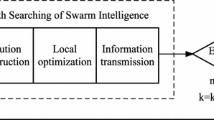Abstract
In this article, we present a multi-objective discrete particle swarm optimizer (DPSO) for learning dynamic Bayesian network (DBN) structures. The proposed method introduces a hierarchical structure consisting of DPSOs and a multi-objective genetic algorithm (MOGA). Groups of DPSOs find effective DBN sub-network structures and a group of MOGAs find the whole of the DBN network structure. Through numerical simulations, the proposed method can find more effective DBN structures, and can obtain them faster than the conventional method.
Similar content being viewed by others
Explore related subjects
Discover the latest articles, news and stories from top researchers in related subjects.References
Murphy K (2002) Dynamic Bayesian networks: representation, inference and learning. PhD Thesis, Computer Science Division, UC Berkeley
Guo W, Gao X, Xiao Q (2008) Bayesian optimization algorithm for learning structure of dynamic Bayesian networks from incomplete data. Proceedings CCDC 2008, pp 2088–2093
Ross BJ, Zuvria E (2007) Evolving dynamic Bayesian networks with multi-objective genetic algorithms. Appl Intell 26(1):13–23
Steuer RE (1986) Multiple criteria optimization: theory, computations, and application. Wiley, New York
Kennedy J, Eberhart R (1997) A discrete binary version of the particle swarm optimization algorithm. Proceedings SMC’ 97, pp 4104–4109
Coello CAC, Pulido GT, Lechuga MS (2004) Handling multiple objectives with particle swarm optimization. IEEE Trans Evolut Comput 8(3):256–279
Author information
Authors and Affiliations
Corresponding author
Additional information
This work was presented in part at the 16th International Symposium on Artificial Life and Robotics, Oita, Japan, January 27–29, 2011
About this article
Cite this article
Shibata, K., Nakano, H. & Miyauchi, A. A learning method for dynamic Bayesian network structures using a multi-objective particle swarm optimizer. Artif Life Robotics 16, 329–332 (2011). https://doi.org/10.1007/s10015-011-0943-7
Received:
Accepted:
Published:
Issue Date:
DOI: https://doi.org/10.1007/s10015-011-0943-7




